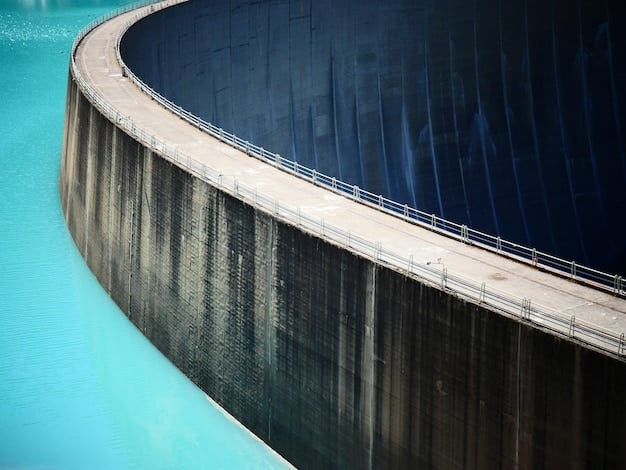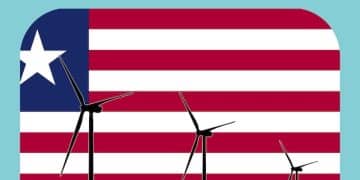Mexico’s New Environmental Regulations for US Businesses

Mexico’s updated environmental regulations are crucial for US businesses operating or planning to enter the Mexican market, necessitating a proactive understanding of compliance frameworks to mitigate risks and ensure sustainable operations.
Navigating the complex landscape of international business requires a keen eye on evolving regulatory frameworks. For US companies with interests in Mexico, understanding Mexico’s New Environmental Regulations: What US Businesses Need to Know to Stay Compliant is not just a matter of good practice; it is a critical mandate for sustained operation and growth.
Understanding Mexico’s Evolving Environmental Landscape
Mexico’s commitment to environmental protection has been steadily growing, fueled by international agreements and an increasing domestic awareness of ecological concerns. This evolution is vital for US businesses to track, as new legislation directly impacts operational costs, supply chains, and market access.
The regulatory shift reflects global trends towards sustainability and corporate accountability. Businesses failing to adapt risk not only hefty fines but also significant reputational damage, which can be far more costly in the long run. Staying informed about these changes is therefore not optional but essential.
Key Regulatory Bodies and Frameworks
Mexico’s environmental governance is primarily overseen by the Secretariat of Environment and Natural Resources (SEMARNAT). This body is responsible for setting policies, enacting regulations, and enforcing compliance across various sectors. Understanding SEMARNAT’s purview is the first step for any US business seeking to navigate Mexican environmental law.
Beyond SEMARNAT, other agencies play crucial roles in specific areas. For instance, the Federal Attorney for Environmental Protection (PROFEPA) acts as the enforcement arm, conducting inspections and imposing sanctions. Knowing the roles of these entities helps businesses anticipate oversight and prepare for audits.
- SEMARNAT: The primary federal agency for environmental policy and regulation.
- PROFEPA: The enforcement agency, responsible for inspections and compliance verification.
- CONAGUA: Manages national water resources and related environmental issues.
- Mexican Official Standards (NOMs): Specific technical regulations that define environmental requirements.
These frameworks are constantly updated, often in response to new scientific findings, international agreements, and economic developmental goals. Businesses should subscribe to official government publications and engage with legal counsel specializing in Mexican environmental law to stay abreast of the latest changes.
Furthermore, local and state-level regulations can add layers of complexity. While federal laws provide a baseline, specific regions or municipalities might impose stricter environmental requirements, particularly in highly industrialized zones or ecologically sensitive areas. Comprehensive due diligence is paramount for businesses operating across multiple locations in Mexico.
In essence, a multi-faceted approach to understanding Mexico’s environmental landscape involves tracking federal mandates, staying informed on the activities of key regulatory bodies, and paying close attention to sub-national regulations that may apply to specific operational sites.
New Regulations Impacting Waste Management and Recycling
One of the most significant areas of change in Mexico’s environmental regulations pertains to waste management and recycling. The country is moving towards a circular economy model, emphasizing waste reduction, reuse, and recycling over traditional landfill disposal. For US businesses, this translates into new obligations concerning their waste streams.
New regulations introduce stricter classifications of waste, requiring companies to implement more sophisticated sorting and disposal practices. This extends beyond hazardous waste to include general and special handling waste, each with distinct requirements for collection, storage, transport, and final disposition.
Enhanced Producer Responsibility (EPR) Schemes
A notable development is the increasing adoption of Extended Producer Responsibility (EPR) schemes. EPR places the responsibility for the entire life cycle of products, and especially for their end-of-life environmental impact, squarely on the manufacturers and importers. This means US businesses that produce or import goods into Mexico may be required to partake in or fund recycling and disposal programs for their products.
EPR initiatives often target specific product categories, such as packaging, electronics, batteries, and tires. Compliance may involve establishing take-back programs, contributing to collective recycling schemes, or demonstrating that a certain percentage of post-consumer waste is recycled. Businesses should assess their product portfolios to identify where EPR obligations might apply.
- Packaging Waste: New regulations mandate a percentage of recycled content and dictate recyclable design.
- Electronics (E-waste): Producers are responsible for collection and proper disposal of electronic goods.
- Batteries: Schemes are being rolled out for the collection and recycling of various battery types.
- Tires: Regulations aim to reduce the environmental impact of discarded tires through producer responsibility.
The shift towards EPR represents a substantial operational and financial implication for many US businesses. It necessitates a re-evaluation of product design, supply chain management, and end-of-life strategies. Early engagement with these requirements can provide a competitive advantage and ensure seamless market access.
Moreover, the transparency and traceability of waste streams are becoming increasingly important. Companies are expected to maintain meticulous records of their waste generation, handling, and disposal, often requiring specialized software or third-party services to ensure accurate reporting to authorities. Proactive investment in these systems can prevent compliance issues down the line.
The regulations also encourage the development of reverse logistics networks, where products or materials are sent back up the supply chain for reuse or recycling. This introduces new logistical challenges and opportunities for businesses to collaborate with suppliers, consumers, and waste management operators to build more sustainable systems.
Water Use and Discharge Regulations Under Scrutiny

Water scarcity and pollution are pressing environmental issues globally, and Mexico is no exception. New regulations are significantly tightening controls on water usage, discharge quality, and wastewater treatment. US businesses operating facilities in Mexico, especially those with high water consumption or effluent discharge, must pay close attention to these evolving standards.
The National Water Commission (CONAGUA) is the primary authority governing water resources in Mexico. Recent updates to water laws and NOMs are imposing stricter limits on the permissible levels of pollutants in industrial wastewater discharge. This may necessitate upgrades to existing treatment facilities or the adoption of new technologies to meet compliance thresholds.
Permitting Processes and Compliance Challenges
Obtaining and maintaining water usage and discharge permits is becoming more rigorous. Businesses must demonstrate not only their compliance with current standards but also their capacity for continuous improvement in water management practices. This includes regular monitoring and reporting of water consumption and effluent quality to CONAGUA.
Compliance challenges often arise from outdated infrastructure or lack of awareness regarding the specific requirements for different types of discharge. For instance, discharge into municipal sewage systems may have different standards than direct discharge into national water bodies. Understanding these nuances is crucial for avoiding violations.
- Increased Monitoring: More frequent and detailed monitoring of water intake and discharge.
- Stricter Discharge Limits: Lower permissible pollutant levels in industrial wastewater.
- Advanced Treatment Technologies: Potential requirement for advanced treatment solutions.
- Permit Renewals: More stringent criteria for the renewal of water rights and discharge permits.
Additionally, some regulations are promoting water conservation and efficiency. Businesses may be encouraged or even mandated to implement measures such as rainwater harvesting, industrial water reuse, and process optimization to reduce their overall water footprint. These initiatives can lead to significant operational savings in the long term, beyond just compliance.
The implications for US businesses are multifaceted, ranging from capital investments in treatment infrastructure to operational adjustments in production processes. Proactive engagement with water management audits and seeking expert advice on permit management can help businesses stay ahead of regulatory changes and avoid costly penalties.
The evolving water regulations in Mexico underscore a global shift towards managing water as a precious and finite resource. Businesses that embrace water stewardship not only comply with laws but also enhance their sustainability profile and resilience against future resource constraints.
Air Quality and Emissions Standards: A Tigher Grip
Air pollution remains a critical concern in many industrialized areas, and Mexico has been bolstering its air quality regulations to address this. New standards for industrial emissions, particularly from manufacturing and energy sectors, are becoming more stringent. US businesses operating facilities that generate air emissions must adjust their operations to meet these updated requirements.
The focus is on reducing emissions of greenhouse gases, volatile organic compounds (VOCs), and particulate matter. This involves not only installing and maintaining appropriate emission control technologies but also implementing robust monitoring and reporting protocols. Older facilities may face significant challenges in meeting newer, tighter standards.
Regulatory Updates and Mitigation Strategies
Recent regulatory updates include revisions to Maximum Permissible Emission Limits (MPELs) for various industrial sources. This means that previously compliant operations might now exceed the new limits, necessitating immediate action. Businesses need to conduct thorough emissions inventories and assessments to identify areas of non-compliance.
Mitigation strategies can range from process optimization and fuel switching to the installation of advanced air pollution control equipment such as scrubbers, filters, and catalytic converters. The choice of strategy will depend on the specific emission sources and the type of pollutants.
- New MPELs: Stricter limits for various industrial air pollutants.
- Continuous Monitoring: Requirement for continuous emission monitoring systems (CEMS) for certain sources.
- Emissions Reporting: More detailed and frequent reporting to environmental authorities.
- Permit Revisions: Existing air emission permits may need to be revised to reflect new standards.
Furthermore, businesses should be aware of regional air quality programs, especially in highly populated or industrialized areas. These programs might impose additional restrictions or require participation in emissions trading schemes. Understanding the interplay between federal and local air quality regulations is essential.
Failure to comply with air quality standards can result in severe penalties, including operational shutdowns and criminal charges in extreme cases. Investing in proper air quality management systems and ongoing training for personnel tasked with compliance is a sound business decision.
The drive for cleaner air in Mexico aligns with broader global efforts to combat climate change and reduce health impacts from air pollution. US businesses that proactively adopt best available technologies and practices in air quality management can demonstrate environmental leadership and enhance their social license to operate.
Environmental Impact Assessments (EIAs) and Permits
Environmental Impact Assessments (EIAs) remain a foundational element of Mexico’s environmental regulatory framework, but recent changes have made the process more rigorous and transparent. For US businesses planning new projects or significant expansions in Mexico, navigating the EIA process successfully is a prerequisite for project approval and avoiding delays.
The revised regulations emphasize a more comprehensive evaluation of potential environmental impacts, including cumulative effects and the social implications of projects. This means that an EIA is no longer just a technical document but a holistic assessment that considers the broader ecological and community context.
Streamlined, Yet Stricter, Approval Processes
While efforts have been made to streamline the administrative aspects of EIA submissions, the substantive requirements have become stricter. Proponents of new projects must demonstrate a thorough understanding of potential environmental risks and present robust mitigation and management plans. Public consultation elements within the EIA process have also been strengthened.
Key changes include increased scrutiny of baseline studies, more detailed impact prediction methodologies, and a greater emphasis on compensatory measures for unavoidable impacts. For US businesses, this means investing more time and resources upfront in the planning and assessment phases of a project.
- Enhanced Scope: EIAs now require broader consideration of ecological and social impacts.
- Public Participation: Expanded opportunities for public input and consultation.
- Mitigation Plans: Detailed and verifiable plans for impact mitigation and compensation.
- Post-Approval Monitoring: More stringent requirements for monitoring environmental performance after project approval.
The integration of digital platforms for EIA submission and tracking aims to increase transparency and efficiency. However, the technical complexity and the need for specialized knowledge in Mexican environmental law and regional ecology remain significant. Engaging local environmental consultants with proven expertise in Mexican EIAs is highly advisable.
Furthermore, any significant modification or expansion of an existing facility may also trigger the need for a new EIA or a permit modification. Businesses should regularly review their operational changes against the thresholds that necessitate new environmental approvals.
Successfully navigating the EIA and permitting processes is not just about compliance; it’s about building a foundation of environmental stewardship that can enhance a business’s reputation and long-term viability in Mexico. Proactive engagement with regulatory authorities and local communities can also help smooth the approval path.
Renewable Energy and Sustainable Practices Incentives
Amidst stricter environmental regulations, Mexico is also actively promoting renewable energy and sustainable business practices through various incentives and regulatory frameworks. For US businesses, this presents opportunities not only for compliance but also for securing cost savings, enhancing brand image, and contributing to global sustainability goals.
The country has set ambitious goals for renewable energy generation and is encouraging investment in solar, wind, geothermal, and other clean energy technologies. Regulations support grid integration of renewables and offer favorable conditions for companies that generate their own clean energy or purchase it from certified sources.
Government Programs and Financial Support
Various government programs and financial incentives are available for businesses that adopt sustainable practices. These can include tax breaks, preferential loan rates, and grants for projects focused on energy efficiency, waste reduction, and the adoption of cleaner production technologies. Staying informed about these opportunities can significantly offset the costs of environmental compliance.
Beyond direct financial incentives, demonstrating a commitment to sustainability can open doors to new markets and attract environmentally conscious consumers and investors. Mexico’s push for green growth aligns with global corporate responsibility trends, making sustainable practices a competitive advantage.
- Tax Incentives: Reductions or exemptions for investments in renewable energy and green technologies.
- Green Financing: Access to loans and credits from national and international development banks.
- Carbon Market Mechanisms: Opportunities to participate in carbon trading or offset schemes.
- Energy Efficiency Programs: Support for implementing measures to reduce energy consumption.
For US businesses, exploring opportunities in renewable energy adoption can lead to reduced operational costs in the long term, stable energy supply, and a buffer against fluctuating fossil fuel prices. It also helps in fulfilling potential corporate sustainability mandates or ESG (Environmental, Social, and Governance) targets.
This includes not just installing solar panels or wind turbines, but also optimizing energy use in existing operations, adopting cleaner manufacturing processes, and investing in sustainable supply chain management. The holistic approach to sustainability enhances a company’s resilience.
Mexico’s dual approach of strengthening regulations while offering incentives for green initiatives creates a dynamic environment. Businesses that strategically leverage these opportunities can turn compliance challenges into pathways for innovation and sustainable growth.
Navigating Compliance: Best Practices for US Businesses
Given the rapidly evolving environmental regulatory landscape in Mexico, US businesses active in or looking to enter the market must adopt robust compliance strategies. Proactive engagement, cross-functional collaboration, and continuous monitoring are essential to mitigate risks and ensure smooth operations.
The complexity of Mexican environmental law, coupled with variations at state and local levels, necessitates a structured approach to compliance. Simply reacting to new regulations as they arise is often insufficient and can lead to costly penalties and operational disruptions.
Proactive Strategies for Risk Mitigation
One of the foremost best practices is to conduct regular, comprehensive environmental audits of all Mexican operations. These audits should assess compliance with current federal, state, and local regulations, identify potential areas of non-compliance, and recommend corrective actions. This proactive approach helps in identifying gaps before they become major issues.
Another key strategy is to invest in specialized legal and environmental consulting expertise. Local Mexican environmental lawyers and consultants possess an in-depth understanding of the laws, the regulatory agencies, and the cultural context, which is invaluable for navigating complex permitting processes and enforcement actions.
- Regular Environmental Audits: Periodic assessments of compliance across all operations.
- Expert Legal and Consulting Support: Engage local specialists in Mexican environmental law.
- Employee Training: Ensure all relevant personnel are aware of environmental responsibilities.
- Stakeholder Engagement: Build positive relationships with local communities and regulatory bodies.
Furthermore, establishing a robust internal Environmental Management System (EMS) is crucial. An EMS, such as one based on ISO 14001 standards, provides a systematic framework for managing environmental impacts, setting objectives, and monitoring performance. It ensures a consistent approach to environmental compliance across all facilities.
Effective communication channels within the company are also vital. Ensuring that changes in regulations are promptly disseminated to relevant departments—from engineering and operations to legal and procurement—can prevent isolated compliance failures and foster a culture of environmental responsibility.
Finally, consider the broader implications of environmental performance on your business’s ESG profile. Strong environmental compliance and demonstrable sustainability efforts can enhance investor confidence, improve access to capital, and strengthen brand reputation in all markets, including the US and Mexico.
Businesses that embrace these best practices will not only navigate the complexities of Mexico’s new environmental regulations successfully but also position themselves as responsible and sustainable corporate citizens, driving long-term value and competitive advantage.
| Key Area | Brief Description |
|---|---|
| 🗑️ Waste Management | Stricter rules for waste disposal and emphasis on Extended Producer Responsibility (EPR) for various products. |
| 💧 Water Usage | Tighter controls on water discharge quality and increased scrutiny on water consumption permits. |
| 💨 Air Quality Standards | More stringent limits on industrial air emissions and enhanced monitoring requirements. |
| ✅ Compliance Strategy | Conduct regular audits, seek expert local counsel, implement EMS, and engage stakeholders proactively. |
Frequently Asked Questions About Mexico’s Environmental Regulations
SEMARNAT (Secretariat of Environment and Natural Resources) is Mexico’s primary federal agency responsible for setting environmental policies, enacting regulations, and overseeing their enforcement. It establishes the framework for environmental protection, including natural resource management, pollution control, and climate change mitigation, guiding all related regulatory actions.
New waste management regulations, particularly Extended Producer Responsibility (EPR) schemes, require US businesses to take on more responsibility for their products’ end-of-life. This involves mandates for recycling, proper disposal, and contributing to sustainability programs. Companies may need to redesign products or join collective schemes to comply with these stricter rules.
Mexico’s updated water discharge regulations, managed by CONAGUA, impose stricter limits on pollutants in industrial wastewater. Facilities must enhance their treatment processes, implement more frequent monitoring, and ensure compliance with new permissible levels. Obtaining and renewing water usage and discharge permits has also become more rigorous, requiring detailed reporting.
EIAs are more critical now because recent regulatory changes have made the assessment process more comprehensive and stringent. They require a broader evaluation of ecological and social impacts, including cumulative effects. This ensures that new projects or expansions undergo thorough scrutiny, with an emphasis on robust mitigation plans and increased public participation elements.
Yes, Mexico offers various incentives for businesses to adopt renewable energy and sustainable practices. These include tax breaks, preferential loan rates, and grants for green technology investments. Embracing renewable energy can lead to long-term cost savings, enhance a company’s environmental profile, and contribute to Mexico’s ambitious clean energy goals.
Conclusion

The evolving environmental regulatory landscape in Mexico presents both challenges and opportunities for US businesses. Staying compliant with stricter waste, water, and air quality standards, as well as navigating more rigorous EIA processes, is essential for continued operation and market access. However, proactive engagement, strategic investment in sustainable practices, and leveraging available incentives can transform these regulatory demands into competitive advantages. By embracing environmental stewardship, US businesses can not only mitigate risks and avoid penalties but also enhance their brand reputation, operational efficiency, and long-term sustainability in the Mexican market. The key lies in continuous monitoring, securing expert guidance, and integrating environmental considerations into the core of business strategy, ensuring a resilient and responsible presence south of the border.





